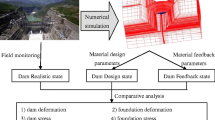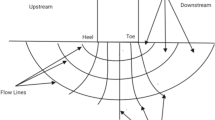Abstract
Appropriate layer quantity has been considered to model the sequential construction of a high embankment dam over 300 m and its effect on the predicted settlement of the 314 m high Shuangjiangkou dam has been discussed. The simulation results have demonstrated that at least 25 layers are required to accurately model the stage construction of a high embankment dam over 300 m. The stress and deformation within the dam and the foundation during the dam construction and reservoir filling have been simulated using finite element analysis. Saturated-unsaturated seepage theory is used to analyse the transient seepage field in the dam and in the foundation. Two different cases about the construction and the operation are modelled. One involves gradual reservoir filling after the completion of sequential construction, whereas the other involves sequential construction and reservoir impounding by several interleaved stages. The simulation results for both cases have been compared and discussed.
Similar content being viewed by others
References
Adikari, G. S. N. and Parkin, A. K. (1982). “Deformation behaviour of Taibingo Dam.” International Journal for Numerical and Analytical Methods in Geomechanics, Vol. 6, No. 3, pp. 353–382.
Alonso, E. E., Gens, A., and Josa, A. (1990). “A constitutive model for partially saturated soils.” Geotechnique, Vol. 40, No. 3, pp. 405–430.
Alonso, E. E., Olivella, S., and Pinyol, N. M. (2005). “A review of Beliche Dam.” Geotechnique, Vol. 55, No. 4, pp. 267–285.
Boughton, N. O. (1970). “Elastic analysis for behavior of rockfill.” Journal of Soil Mechanics and Foundation Division, ASCE, Vol. 96, No. SM 5, pp. 1715–1733.
Byrne, P. M., Cheung, H., and Yan, L. (1987). “Soil parameters for deformation analysis of sand masses.” Canadian Geotechnical Journal, Vol. 24, No. 3, pp. 366–376.
Chen, W. F. and Zhang, H. (1990). Structural plasticity: Theory, problems, and CAE software, Springer-Verlag.
Clough, R. W. and Woodward, R. J. (1967). “Analysis of embankment stresses and deformations.” Journal of Soil Mechanics and Foundation Division, ASCE, Vol. 93, No. SM 4, pp. 529–549.
Costa, L. M. and Alonso, E. E. (2009). “Predicting the behavior of an earth and rockfill dam under construction.” Journal of Geotechnical and Geoenvironmental Engineering, ASCE, Vol. 135, No. 7, pp. 851–862.
Dakshanamurthy, V., Fredlund, D. G., and Rahardjo, H. (1984), “Coupled three dimensional consolidation theory of unsaturated porous media.” Proceedings of the Fifth International Conference on Expansive Soils, Adelaide, Australia, pp. 99–103.
Duncan, J. M. and Chang, C. Y. (1970). “Nonlinear analysis of stress and strain in Soils.” Journal of Soil Mechanics and Foundation Division, ASCE, Vol. 96, No. SM 5, pp. 1629–1653.
Fredlund, D. G. and Rahardjo, H. (1993). Soil mechanics for unsaturated soils, John Wiley & Sons, Inc., New York.
Fredlund, M. D., Wilson G. W., and Fredlund, D. G. (2002). “Use of the grain-size distribution for estimation of the soil-water characteristic curve.” Canadian Geotechnical Journal, Vol. 39, No. 5, pp. 1103–1117.
Fredlund, D. G., Xing, A., and Huang, S. (1994). “Predicting the permeability function of unsaturated soils using soil-water characteristic curve.” Canadian Geotechnical Journal, Vol. 31, No. 4, pp. 533–546.
Geo-slope International Ltd. (2007). Seepage modeling with SIGMA/W, An Engineering Methodology, Second Edition.
Hydro-China Chengdu Engineering Corporation (2008). Feasibility research report of shuangjiangkou hydropower station (in Chinese).
Khalid, S., Singh, B., Nayak, G. C., and Jain, O. P. (1990). “Nonlinear analysis of concrete face rockfill dam.” Journal of geotechnical engineering, Vol. 116, No. 5, pp. 822–837.
Kulhawy, F. H. and Duncan, J. M. (1972). “Stresses and movements in Oroville Dam.” Journal of Soil Mechanics and Foundation Division, ASCE, Vol. 98, No. SM7, pp. 653–665.
Liu, S., Cheng, Z. L., Chen, Y., and Ren, Z. W. (1999). “Nonlinear and elasto-plastic analysis for high concrete-faced rockfill dam of shuibuya project.” Journal of Yangtze River Scientific Research Institute, Vol. 16, No. 1, pp. 26–32 (in Chinese).
Martin, H. L. (1978) “A three-dimensional deformation analysis of the Storvass dam.” International Journal for Numerical and Analytical Methods in Geomechanics, Vol. 2, No. 1, pp. 3–17.
Naylor, D. J., Maranha das Neves, E., Mattar, D. Jr., and Veiga Pinto, A. A. (1986). “Prediction of construction performance of Beliche dam.” Geotechnique, Vol. 36, No. 3, pp. 359–376.
Naylor, D. J. and Pande, G. N. (1981). Finite elements in geotechnical engineering, Swansea, Pineridge.
Sharma, H. D., Nayak, G. C., and Maheshwari, J. B. (1979). “Nonlinear analysis of a high rockfill dam with earth core.” Transaction of 13th Int Congr on Large Dams, Technology Review, Vol. 1, pp. 879–894.
Shen, Z. J. (1987). “Effective stress-strain analysis of a core type rockfill dam at Lubuge hydroelectric plant.” Journal of Hydroelectric Engineering, No. 1, pp. 5–21 (in Chinese).
Shen, Z. J. (1990). “A new model for stress-strain analysis of soils.” Proceedings of 5th soil mechanics and foundation engineering, China Architecture & Building Press, Beijing, pp. 101–105 (in Chinese).
Shen, Z. J. and Wang, J. P. (1990). “Effective stress-strain analysis of the earth-rock dam in Hengshan reservoir.” Chinese Journal of Hydraulic Engineering, Vol. 21, No. 4, pp. 59–65 (in Chinese).
Shen, Z. J. and Zhang, W. X. (1991). “Effective stress-strain and movement of Xiaolangdi slope core rockfill dam.” Hydro-Science and Engineering, No. 4, pp. 361–373 (in Chinese).
Sun, T., Gao, X-Z., and Yang, J. (2006). “Stress-strain anlaysis of Zipingpu concrete faced rockfill dam.” Rock and Soil Mechanics, Vol. 27, No. 2, pp. 247–251 (in Chinese).
The Construction Ministry of People’s Republic of China (2002). GB50010-2002 code for design of concrete structures, China Architecture and Building Press, China (in Chinese).
Yang, R. (1995). “The 3-D nonlinear stress-strain analysis of Pubugou high rockfill dam.” Journal of Basic Science and Engineering, Vol. 3, No. 3, pp. 260–267 (in Chinese).
Author information
Authors and Affiliations
Corresponding author
Rights and permissions
About this article
Cite this article
Chen, Q., Zou, Y.H., Tang, M. et al. Modelling the construction of a high embankment dam. KSCE J Civ Eng 18, 93–102 (2014). https://doi.org/10.1007/s12205-014-0180-4
Received:
Revised:
Accepted:
Published:
Issue Date:
DOI: https://doi.org/10.1007/s12205-014-0180-4




